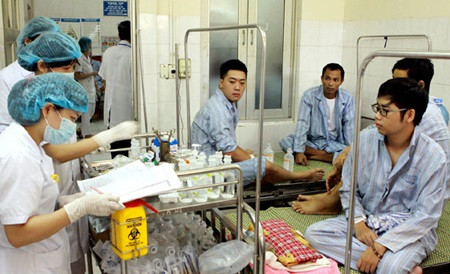HCM City (VNA) - The building and upgrading of new health facilities in the country as well as the improved capacity of doctors, especially at the grassroots level, has helped reduce patient overload at hospitals.
At a review meetings held in Ho Chi Minh City on March 3, Luong Ngoc Khue, head of the Medical Examination and Treatment Department, said that hospital facilities, especially in the fields of oncology, surgery-trauma, heart, obstetrics and paediatrics, had been either built or upgraded.
These activities were all part of a Ministry of Health plan to reduce patient overload.
At central-level hospitals (those managed by the central government), work was done on 15 hospitals and centres with a total of 4,765 beds. The hospitals also received advanced equipment.
These included the Oncology Centre at Cho Ray Hospital in HCM City, and the National Geriatric Hospital.
Also improved was the ratio of beds per 10,000 people last year increased to 31.2, while it was 24.7 in 2012.
Hospitals also set up family doctor clinics.
"Patient overload is being solved step by step," Khue said, adding that patient satisfaction was better because of higher quality.
The examination process at hospitals now takes four to eight steps, down from the former 12-14 steps.
Patients' waiting time has also fallen to an average of 48.5 minutes, saving 27.2 million of labour days a year.
In January, the Ministry of Health told hospitals under the ministry's management to pledge that patients would no longer share beds after 24 hours of being hospitalised.
Thirty-five out of 39 central-level hospitals nationwide so far have carried out the commitment.
Many programmes send doctors of central- and city-level hospitals to improve the capacity of doctors at lower-level hospitals.
This has helped reduce patient overload at central- and city-level hospitals, Khue said.
In addition, advanced techniques in treatment such as robotic surgery and continuous blood purification have been applied.
Khue said that hospital quality last year improved compared to 2013 and 2014.
Hospitals at the central level had an average score of 3.5 for quality out of a maximum of five. It was 2.8 for city-level hospitals and 2.6 for those in districts.
The scores for private hospitals ranged from 2.53-2.9.
Last year, hospitals nationwide admitted more than 146 million outpatient turns, an increase of 4.5 per cent compared to 2014.
The number of inpatient turns was 13.5 million.
Khue told leaders of hospitals in HCM City and other southern provinces and cities to strengthen inspection and surveillance of safety and proper drug usage.
He also asked that they pay more attention to drug resistance, infections, clinical nutrition and radiation safety during patient examination and treatment.-VNA



























